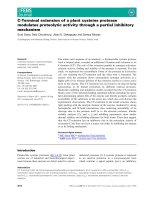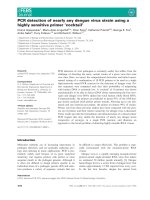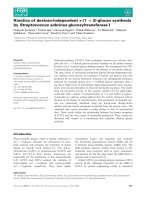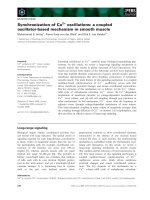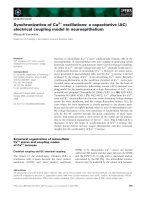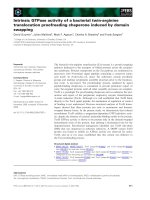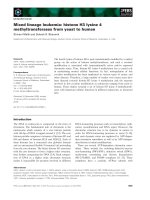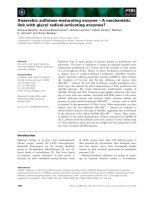Tài liệu Báo cáo khoa học: "Word Order in German: A Formal Dependency Grammar Using a Topological Hierarchy" pptx
Bạn đang xem bản rút gọn của tài liệu. Xem và tải ngay bản đầy đủ của tài liệu tại đây (216.31 KB, 8 trang )
Word Order in German:
A Formal Dependency Grammar Using a Topological Hierarchy
Kim Gerdes
Lattice, Université Paris 7
75251 Paris Cedex 05
France
Sylvain Kahane
Lattice, Université Paris 7
75251 Paris Cedex 05
France
Abstract
This paper proposes a description of
German word order including phe-
nomena considered as complex,
such as scrambling, (partial) VP
fronting and verbal pied piping. Our
description relates a syntactic de-
pendency structure directly to a
topological hierarchy without re-
sorting to movement or similar
mechanisms.
1
1 Introduction
The aim of this article is to describe the word
order of German verbs and their comple-
ments. German word order is not free, but
based on fairly simple rules, forming what is
usually called topological model, which sub-
divides the sentence into a hierarchy of topo-
logical domains that are themselves composed
of fields (Vorfeld, Mittelfeld, right bracket…)
(Drach, 1937; Bech, 1955).
We start from a syntactic dependency tree, i.e.
an unordered tree whose nodes are labeled
with the words of the sentence, and whose
branches are labeled with syntactic relations
among the words (subject, direct object…).
The syntactic dependency structure only en-
codes subcategorization and modification and
must be completed by the communicative
structure (partition into theme/rheme, focus…),
which plays a fundamental role in word order.
It permits us to choose among all the different
possible orders corresponding to a given de-
pendency structure. In this paper we do not
1
We would like to thank Werner Abraham, Tilman
Becker, Ralph Debusmann, Denys Duchier, and
Stefan Müller for fruitful discussions. Particular
thanks to Igor Mel'cuk for the inspiration of the
particular status we give to the phrase structure.
pursue this problem any further, but have
limited our description to the link between
dependency and topology. Note that it is fun-
damental to our approach that syntactic
structure does not include word order.
To get the words in order, we group them in a
hierarchy of phrases. The nature and the posi-
tion of these phrases are constrained by our
topological model. For instance, a non-finite
verb can open two kinds of topological
phrases, either a phrase, which we call domain,
with positions for all of its dependents, or a
restricted phrase, which forms the verb cluster,
with no positions for dependents other than
predicative elements. These two kinds of
phrases must be placed in very different
topological positions.
The fact that we pass through a (topological)
phrase structure in order to relate dependency
and word order distinguishes our approach
from usual dependency grammars (Mel'cuk &
Pertsov, 1987; Bröker, 1998; Kahane et al.,
1998; Duchier & Debusmann, 2001). The
description of German word order closest to
our analysis is the HPSG grammar of Kathol
(1995; see also Reape 1994), who proposes
linearization rules exclusively based on a for-
malization of the topological structure. How-
ever, as required by the formalism he uses, a
regular phrase structure, which we do not need
in our analysis, still underlies the structures
obtained.
Our work constitutes a syntactic module which
links (unordered) syntactic structures with
topological phrase structures. Syntactic struc-
tures are related to semantic structures,
whereas topological phrase structures are re-
lated to phonological structures. In other
words, our work lies within the scope of the
general framework of Meaning-Text-Theory
(Mel'cuk 1988), which considers the modeling
of a language as a modular (bi-directional)
correspondence between meaning and text. It
must be clear that, in contrast to X-bar syntax,
our topological phrase structure does not rep-
resent the syntactic structure of the sentence.
Although the dependency information is es-
sential in its construction, the phrase structure
only represents topology, i.e. the surface
grouping of the words. Topological phrases
can be directly related to prosodic groups, and
topology represents an intermediate level be-
tween dependency and phonology.
In Section 2, the results of our findings are
presented, without recourse to any mathemati-
cal formalism, in the usual terminology of
traditional German grammars. In Section 3, a
mathematical formalism is proposed to state
the rules and the grammar fragment described
in Section 2.
2 Description
Word order in German is much freer than in
English. The dependency tree of Fig. 1, which
will be our reference example, has a few dozen
linearizations:
(1) a. Niemand hat diesem Mann das Buch
zu lesen versprochen
b. Diesem Mann hat das Buch niemand
zu lesen versprochen
c. Das Buch zu lesen hat diesem Mann
niemand versprochen
d. Diesem Mann hat niemand verspro-
chen, das Buch zu lesen
e. Diesem Mann hat, das Buch zu lesen,
niemand versprochen
f. Zu lesen hat diesem Mann das Buch
niemand versprochen
g. Das Buch hat niemand diesem Mann
versprochen zu lesen
‘Nobody promised this man to read the
book.’
Fig. 1. Dependency tree of the sentences in (1)
In this paper, we do not attempt to characterize
well-formed German dependency trees al-
though we recognize that such a characteriza-
tion is essential if we attempt to describe the
acceptable sentences of German.
2.2 Topological model
The internal structure of a domain is a se-
quence of fields. For example, the main do-
main is the underlying pattern of a declarative
sentence, and it consists of the following se-
quence of five fields: [Vorfeld, left bracket,
Mittelfeld, right bracket, Nachfeld]. A domain
resembles a box whose ordered compartments,
called fields, can themselves accommodate
new boxes. In addition to the rules listing the
fields of each type of box, we propose two
further types of rules:
• rules that indicate into which field a word
can go–depending on the position of its
governor;
• rules that indicate which type of box a
word can create when it is placed into a
given field.
The hierarchy of boxes forms the phrase
structure we construct.
2.3 Word order rules
We have established the following rules for the
linear order of verbs and their dependents:
• The finite verb takes the second position
of the main domain, the left bracket. This
verb is also called V2.
• A non-finite verb depending on V2 can
go into the right bracket.
2
As a result, it
opens a reduced phrase with only one po-
sition for a verbal dependent (see Section
2.8 for another possibility). If a subse-
quent third verb joins the verb already in
the right bracket, it will again open a
phrase with a position to its left, and so on.
The verbal constituent occupying the right
bracket is called the verb cluster.
• Some non-verbal dependents, such as
separable verbal prefixes (for example the
an of anfangen ‘begin’), predicative ad-
jectives, and nouns governed by a copular
verb or a support verb, can go into the
right bracket (the prefix even forms one
word with its following governor). In con-
trast to verbs, these elements do not usu-
ally open up a new position for their de-
pendents, which consequently have to be
placed somewhere else.
3
2
We consider that in a compound verb form such as
hat gelesen ‘has read’ the past participle depends
syntactically on the auxiliary, which is the finite verb
form (cf. Tesnière 1959, Mel'cuk 1988). The V2 is
thus always the root of the syntactic dependency tree.
3
In examples such as (i), the separable verbal prefix
an behaves like a subordinated verb intervening be-
tween the ‘main’ verb and its dependent:
hat ‘has’
niemand
‘noboby’-NOM
dobj
subj
aux
das Buch
‘the book’-ACC
zu lesen
‘to read’
iobj
inf
diesem Mann
‘this man’-DAT
versprochen
‘promised’
• One dependent (verbal or non-verbal) of
any of the verbs of the main domain (V2,
any verb in the right bracket or even an
embedded verb) has to occupy the first
position, called the Vorfeld (VF, pre-
field).
• All the other non-verbal dependents of the
verbs in the domain (V2 or part of the
verbal cluster) can go in the Mittelfeld
(MF, middle-field).
• Some phrases, in particular sentential
complements (complementizer and rela-
tive clauses), prepositional phrases, and
even some sufficiently heavy noun
phrases, can be positioned in a field right
of the right bracket, the Nachfeld (NF, af-
ter-field). Like the Mittelfeld, the Nachfeld
can accommodate several dependents.
• When a verb is placed in any of the Major
Fields (Vor-, Mittel-, Nachfeld), it opens a
new embedded domain.
In the following section we illustrate our rules
with the dependency tree of Fig. 1 and show
how we describe phenomena such as scram-
bling and (partial) VP fronting.
2.4 Non-embedded construction and
“scrambling”
Let us start with cases without embedding, i.e.
where the subordinated verbs versprochen
‘promised’ and zu lesen ‘to read’ will go into
the right bracket of the main domain (Fig. 2).
The constituents which occupy the left and
right brackets are represented by shadowed
ovals. The other three phrases, niemand ‘no-
body’, diesem Mann ‘to this man’, and das
Buch ‘the book’, are on the same domain
level; one of them has to take the Vorfeld, the
other two will go into the Mittelfeld. We obtain
thus 6 possible orders, among them (1a) and
(1b). There are nevertheless some general
restrictions on the relative constituent order in
the Mittelfeld. We do not consider these rules
here (see for instance Lennerz 1977, Uszkoreit
1987), but we want to insist on the fact that the
order of the constituents depends very little on
their hierarchical position in the syntactic
structure.
4
Even if the order is not free, there
(i) Er fängt gleich zu schreien an.
He begins right_away to shout AN.
‘He begins to shout right away.’
4
Dutch has the same basic topological structure, but
has lost morphological case except on pronouns. For
a simplified description of the order in the Dutch
Mittelfeld, we have to attach to each complement
placed in the Mittelfeld its height in the syntactic
are restrictions that weigh more heavily than
the hierarchical position: pronominalization,
focus, new information, weight, etc.
hat ‘has’
niemand
‘noboby’
dobj
subj
aux
das Buch
‘the book’
zu lesen
‘to read’
iobj
inf
diesem Mann
‘to this man’
versprochen
‘promised’
Fig. 2. A phrase structure without embedded do-
mains for (1a,b)
The fact that a verbal projection (i.e. the verb
and all of its direct and indirect dependents)
does not in general form a continuous phrase,
unlike in English and French, is called scram-
bling (Ross, 1967). This terminology is based
on an erroneous conception of syntax that
supposes that word order is always an immedi-
ate reflection of the syntactic hierarchy (i.e.
every projection of a given element forms a
phrase) and that any deviation from this con-
stitutes a problem. In fact, it makes little sense
to form a phrase for each verb and its depend-
ents. On the contrary, all verbs placed in the
same domain put their dependents in a com-
mon pot. In other words, there is no scram-
bling in German, or more precisely, there is no
advantage in assuming an operation that de-
rives ‘scrambled’ sentences from ‘non-
scrambled’ ones.
2.5 Embedding
hat ‘has’
niemand
‘noboby’
subj
aux
zu lesen
‘to read’
diesem Mann
‘to this man’
versprochen
‘promised’
dobj
das Buch
‘the book’
iobj
inf
Fig. 3. A phrase structure with an embedded
domain for (1a, 1c, 1d, 1e)
dependency tree, and linearize them in descending
order.
As we have said, when a verb is placed in one
of the major fields, it opens an embedded
domain. We represent domains by ovals with a
bold outline. In the situation of Fig. 3, where
zu lesen ‘to read’ opens an embedded do-
main, hat ‘has’ and versprochen ‘promised’
occupy the left and right bracket of the main
domain and we find three phrases on the same
level: niemand ‘nobody’, diesem Mann ‘to
this man’, and das Buch zu lesen ‘to read the
book’. The embedded domain can go into the
Vorfeld (1c), the Nachfeld (1d), or the Mit-
telfeld (1a,e).
Note that we obtain the word order (1a) a sec-
ond time, giving us two phrase structures:
(2) a. [Niemand] [hat] [diesem Mann] [das
Buch zu lesen] [versprochen]
b. [Niemand] [hat] [diesem Mann] [das
Buch] [zu lesen versprochen]
This structural ambiguity corresponds, we
believe, to a semantic ambiguity of communi-
cative type: In (2a), the fact of reading the
book is marked (as in Reading the book, no-
body promised him that), whereas (2b) is neu-
tral in this respect (Nobody promised him to
read the book).
Moreover, the structures (2a) and (2b) corre-
spond to different prosodies (the left border
of the right bracket is clearly marked with an
accent on the first syllable of the radical).
Finally, the existence of this ambiguity is also
confirmed by the contrast between full infini-
tives (with zu) and bare infinitives (without zu):
Bare infinitives cannot form an embedded
domain outside of the Vorfeld. Consequently,
there are two different prosodies for (3a) (with
or without detachment of das Buch ‘the
book’ from zu lesen ‘to read’), whereas only
one prosody without detachment is permitted
for (3b), although (3a) and (3b) have isomor-
phic dependency trees. Evidence comes also
from the written form recommending a
comma for (3a) (i.e. preference for the em-
bedded structure), whereas the comma is not
allowed for (3b).
(3) a. Niemand versucht(,) das Buch zu lesen
‘Nobody tries to read the book.’
b. Niemand will das Buch lesen
‘Nobody wants to read the book.’
2.6 Emancipation
The dependents of a verb do not have to be in
their governor’s domain: They can be ‘eman-
cipated’ and end up in a superior domain. For
example, in Fig. 4, the verb zu lesen ‘to read’
has created an embedded domain from which
its dependent das Buch ‘the book’ has been
emancipated. We have thus four complements
to place in the superior domain, allowing more
than thirty word orders, among them (1f) and
(1g). Among these orders, only those that
have das Buch or zu lesen in the Vorfeld are
truly acceptable, i.e. those where embedding
and emancipation are communicatively moti-
vated by focus on das Buch or zu lesen.
hat ‘has’
niemand
‘noboby’
subj
aux
zu lesen
‘to read’
diesem Mann
‘to this man’
versprochen
‘promised’
dobj
das Buch
‘the book’
iobj
inf
Fig. 4. A phrase structure with emancipation for
(1f,g)
2.8 Word order in the right bracket
German permits different orders inside the
verb cluster. The tense auxiliaries haben
‘have’ (past) and werden ‘become/will’ (fu-
ture) also allow their dependents to take a
place on their right in the right bracket
(Oberfeldumstellung or auxiliary flip; Bech,
1955) (4a). The dependents of this verb go
again on the left side of their governor, just as
in standard order (we thus obtain V
1
V
2
,
V
1
V
3
V
2
, V
1
V
4
V
3
V
2
) but it can also join the
place to the left of the auxiliary (we thus ob-
tain the marginal Zwischenstellung V
3
V
1
V
2
(4c), V
4
V
3
V
1
V
2
).
The governed verbs V
2
accepting this inverse
order form a closed class including the modal
and perception verbs and some others (helfen,
‘help’, the causative/permissive lassen
‘make/let’ … – haben ‘have’ itself also allows
this right-placement, which suffices to explain
the cases of ‘double flip’ as in (4b) giving
V
1
V
2
V
4
V
3
). Note that the dependent of haben
‘have’ is the bare infinitive. This form, called
the Ersatzinfinitiv, is also possible or even
preferable for certain verbs when the auxiliary
is in V2 position.
(4) a. Er wird das Buch haben lesen können.
He will the book have read can.
‘He will have been able to read the book.’
b. Ich glaube, dass er das Buch wird ha-
ben lesen können.
I believe that he the book will have read can.
‘I believe that he will have been able to read
the book.’
c. Ich glaube, dass er das Buch lesen wird
können.
I believe that he the book read will can.
‘I believe that he will be able to read the
book.’
In related languages like Dutch or Swiss-
German, which have the same topological
structure, the standard order in the right
bracket is somewhat similar to the German
Oberfeldumstellung. The resulting order gives
rise to cross serial dependencies (Evers 1975,
Bresnan et al. 1982) Such constructions have
often been studied for their supposed com-
plexity. With our subsequent description of
the Oberfeldumstellung, we obtain a formal
structure that applies equally to Dutch. Indeed,
the two structures have identical descriptions
with the exception of the relative order of
dependent verbal elements in the right bracket
(keeping in mind that we do not describe the
order of the Mittelfeld).
2.9 Relatives and pied-piping
Relative clauses open an embedded domain
with the main verb going into the right
bracket. The relative pronoun takes the first
position of the domain, but it can take other
elements along (pied-piping) (5). German
differs from English and Romance languages
in that even verbs can be brought along by the
relative pronoun (5b).
(5) a. Der Mann [[von dem] [Maria] [geküsst
wird]] liebt sie.
The man [[by whom] [Maria] [kissed is]]
loves her.
b. Das war eine wichtige Einnahmequel-
le, [[die zu erhalten] [sich] [die EU]
[verpflichtet hat]].
This was an important source_of_income,
[[that to conserve] [itself] [the EU] [com-
mited has]].
‘This was an important source_of_income,
that the EU obliged itself to conserve.’
Before we discuss the topological structure of
relative clauses, we will discuss their syntactic
representation. Following Tesnière (1959) and
numerous analyses that have since corrobo-
rated his analysis, we assume that the relative
pronoun plays a double syntactic role:
• On one hand, it has a pronominal role in
the relative clause where it fills a syntactic
position.
• On the other hand, it plays the role of a
complementizer allowing a sentence to
modify a noun.
For this reason, we attribute to the relative
pronoun a double position: as a complemen-
tizer, it is the head of the relative clause and it
therefore depends directly on the antecedent
noun and it governs the main verb of the rela-
tive clause. As a pronoun, it takes its usual
position in the relative clause.
verpflichtet
subj
inf
die EU
hat
sich
"die"
eine Einahmequelle
conj
rel
inf
zu
erhalten
die
dobj
dobj
It is now possible to give the word order rules
for relative clauses. The complementizing part
of the relative pronoun opens an embedded
domain consisting of the complementizer field
(Kathol 1995), Mittelfeld, right bracket, and
Nachfeld. The main verb that depends on it
joins the right bracket. The other rules are
identical to those for other domains, with the
group containing the pronominal part of the
relative pronoun having to join the other part
of the pronoun in the complementizer field.
In a sense, the complementizer field acts like
the fusion of the Vorfeld and the left bracket
of the main domain: The complementizing
part of the pronoun, being the root of the
dependency tree of the relative clause, takes
the left bracket (just like the top node of the
whole sentence in the main domain), while the
pronominal part of the relative pronoun takes
the Vorfeld. The fact that the pronoun is one
word requires the fusion of the two parts and
hence of the two fields into one. Note that
verbal pied-piping is very easy to explain in
this analysis: It is just an embedding of a verb
in the complementizer field. Just like the Vor-
feld, the complementizer field can be occu-
pied by a non-verbal phrase or by a verb cre-
ating an embedded domain.
3 Formalization
A grammar in the formalism we introduce in
the following will be called a Topological
Dependency Grammar.
Fig. 5. Dependency and phrase
structure for (5b)
3.1 Definition of the Grammar
For a grammar, the parameters to instantiate
are the vocabulary V, the set of (lexical) cate-
gories C, the set of syntactic relations R, the set
of box names B, the set of field names F, the
initial field i, the order of permeability of the
boxes, which is a partial ordering on B (used
for emancipation) and four sets of rules:
5
1. Box description rules:
The rule b f1 f2 … fn indicates that the box
b consists of the list of fields f1, f2, …, fn.
f1 f2 … fn
b
2. Field description rules:
The pair (f,ε) in F×{!,?,+,∗} indicates that the
field f has to contain exactly one element (!),
at most one element (?), at least one element
(+) or any number of elements (∗).
3. Correspondence rules (between the de-
pendency and the topological structure):
The rule (r,c1,c2,f2,b) indicates that a word w2
of category c2, that exhibits a dependency of
type r on a word w1 of category c1, can go
into field f2 of a box containing w1, if this
box is separated from w1 by borders of type ≤
b (in other words, the parameter b controls the
emancipation).
c1
b
f2
c2
r
>
(In all our figures, boxes are represented by
ovals, fields by rectangles or sections of an
oval.)
4. Box creation rules:
The rule (c,f,b,f’) indicates that a word of
category c, placed into a field f, can create a
box b and go into the field f’ of this box.
Box creation rules are applied recursively until
a lexical rule of type (c,f,b,-) is encountered
where b is a lexical box with a unique lexical
field, into which the word has to be placed.
Phrase structure derivation starting from a
dependency tree
The word labeling the root node of the tree is
placed into the initial field i. Box creation
rules are then activated until the word is placed
5
We will not present lexical rules indicating each
lexical entry’s characteristics, in particular its cate-
gory.
in a lexical field (-). A correspondence rule is
activated for one of the dependents of the root
node, placing it in an accessible field. Just as
for the root node, box creation rules are acti-
vated until the word is assigned to a lexical
field. This procedure continues until the whole
tree is used up. Each time a box creation rule
is triggered, a box is created and a description
rule for this box has to be activated. Finally,
the constraints of the field description rules
have to be respected (e.g. a field requiring at
least one element can not remain empty).
3.2 Example of a grammar
We will now instantiate our formalism for the
German grammar fragment described in sec-
tion 2 (leaving aside non-verbal elements in
the right bracket) and we will put forward the
derivation of (1f) with this grammar (Fig.5).
V = the German words
C = { V, AV, EV, Vfin, Vinf, Vbse, Vpp, …, C,
N, X, Y }
(V = verb, AV = auxiliary verb, EV = verb
with Ersatzinfinitiv, Vfin = finite verb, Vinf
= infinitive with zu, Vbse = base infinitive,
Vpp = past participle, C = complementizer,
X = non-verbal element, Y = anything) ;
R = { r } (we consider a unique syntactic rela-
tion r subsuming all others)
B = { md, ed, cd, vc, vb, v, xp }
(md = main domain, ed = embedded do-
main, cd = comp domain, vc = verbal
cluster, vb = verbal box, v = verb, xp =
non-verbal phrase)
F = { i, vf, [, mf, ], nf, cf, h, o, u, -}
(i = initial field, vf = Vorfeld, ‘[’ = left
bracket, mf = Mittelfeld, ‘]’ = right
bracket, nf = Nachfeld, cf = comp field, h
= head, o = Oberfeld, u = Unterfeld , - =
lexical field, f = vf/mf/nf/cf = major field)
i is the initial field
Permeability order
vb < vc < xp = ed < cd < md
Box description
md -> vf [ mf ] nf
ed -> mf ] nf
cd -> cf mf ] nf
vc -> o h u
vb -> o h
v -> -
xp -> undescribed
Field description
(i,!), (-,!), (vf,!), (cf,!), (mf,∗), (nf,∗), ([,!), (],?),
(h,!), (o,?), (u,?).
mf
]
nf
[
vf
i
[
Vfin
md
hat, Vfin:
versprochen, Vpp:
zu lesen, Vinf:
das Buch, X:
niemand, X:
diesem Mann, X:
+
⇒
⇒
V
]
V
r
>
Y
V
f
r
>
ed
]
h
V
vc
+
+
+
o h u
vc
Y
V
f
r
>
ed
+
f
]
V
ed
+
+
vf ] nf
ed
]
h
V
vc
+
+
o h u
vc
+
Y
V
f
r
>
ed
+
Y
V
f
r
>
ed
+
o h u
vc
mf
[
nf
o h u
vc
[zu lesen] [hat] [diesem Mann] [das Buch] [niemand] [versprochen]
vf
[
mf
]
nf
⇒
i
o h u
vc
mf
[
nf
o h u
vc
vf
[
mf
]
nf
i
ed
ed
⇒
mf
md
]
nf
vf
[
Vfin
i
mf
md
nf
vf
[
Vfin
i
o h u
vc
]
Vfin
Vfin
V
V
V
V
V
X
X
X
Fig. 6. Derivation de (1e)
Correspondence rules
Positioning of the first verb in the right
bracket:
6
(r, Y, V, ], -)
Positioning of a verb to the left of the pre-
ceding verb in the right bracket:
(r, V, V¬fin, o, vc)
Positioning of a verb to the right of the pre-
ceding verb in the right bracket:
7
(r, AV¬inf, EV, u, -)
6
The last parameter (-) indicates that the right
bracket of a given domain is not accessible when
emancipating an element from an embedded domain.
7
Auxiliaries with zu do not allow auxiliary flip:
(i) ∗Er meint das Buch zu haben lesen können.
He thinks the book to have read can.
Positioning of a non-verbal element in a ma-
jor field:
8
(r, V, X, f, ed)
Box creation rules
Creation of the main domain in the initial
field: (Vfin, i, md, [)
Creation of an embedded domain in a major
field: (V¬fin, f, ed, ])
Creation of a verbal cluster in the right
bracket or the Unterfeld: (V,]/u,vc, h)
8
This last parameter indicates that it is possible to
emancipate out of any type of box inferior to ‘ed’ in
the order of permeability, i.e. ed, xp, vb or vc, but
not out of cd. Moreover, this rule puts no restric-
tions on the field of the governor. This rule would
have to be refined to account for NP-internal word
order phenomena.
Creation of a verbal box in the Oberfeld:
(V, o, vb, h)
Positioning of a verb: (V, [/h, v, -)
Creation of a non-verbal phrase: (X, f, xp, ?)
Creation of a domain for a relative clause:
9
("C", f, cd, "cf")
4 Conclusion
We have shown how to obtain all acceptable
linear orders for German sentences starting
from a syntactic dependency tree. To do that
we have introduced a new formalism which
constructs phrase structures. These structures
differ from X-bar phrase structures in at least
two respects: First, we do not use the phrase
structure to represent the syntactic structure of
the sentence, but only for linearization, i.e. as
an intermediate step between the syntactic and
the phonological levels. Secondly, the nature
of the phrase opened by a lexical element
depends not only on the syntactic position of
this element, but also on its position in the
topological structure (e.g. the different be-
haviors of a verb in the right bracket vs. in a
major field).
We have to investigate further in various di-
rections: From a linguistic point of view, the
natural continuation of our study is to find
out how the communicative structure (which
completes the dependency tree) restricts us to
certain word orders and prosodies and how to
incorporate this into our linearization rules. It
would also be interesting to attempt to de-
scribe other languages in this formalism, con-
figurational languages such as English or
French, as well as languages such as Russian
where the surface order is mainly determined
by the communicative structure. However,
German is an especially interesting case be-
cause surface order depends strongly on both
the syntactic position (e.g. finite verb in V2 or
Vfinal position) and the communicative
structure (e.g. content of the Vorfeld).
From a computational point of view, we are
interested in the complexity of our formalism.
It is possible to obtain a polynomial parser
provided that we limit the number of nodes
simultaneously involved in non-projective
configurations (see Kahane et al. 1998 for
similar techniques). Such limitations seem
reasonable for Germanic languages (e.g. verb
9
The quotation marks indicate that the complemen-
tizing part of the relative pronoun is not a real word,
and hence it does not actually occupy the comple-
mentizer field, and must consequently accommodate
another element.
clusters with more than four verbs are un-
usual).
References
Bech Gunnar, 1955, Studien über das deutsche
Verbum infinitum, 2nd edition 1983, Linguisti-
sche Arbeiten 139, Niemeyer, Tübingen.
Bresnan Joan, Ronald M. Kaplan, Stanley Peters,
Annie Zaenen, 1982, “Cross-serial Dependencies
in Dutch”, Linguistic Inquiry 13(4): 613-635.
Bröker Norbert, 1998, “Separating Surface Order and
Syntactic Relations in a Dependency Grammars”,
COLING-ACL’98, 174-180.
Drach, Erich, Grundgedanken der deutschen Satzleh-
re, Diesterweg, Frankfurt, 1937.
Duchier Denys, Ralph Debusmann, 2001,
“Topological Dependency Trees: A Constraint-
Based Account of Linear Precedence”, ACL 2001.
Evers Arnoldus, 1975, The transformational cycle
in Dutch and German. PhD thesis, University of
Utrecht.
Kahane Sylvain, Alexis Nasr, Owen Rambow, 1998,
“Pseudo-Projectivity: a Polynomially Parsable
Non-Projective Dependency Grammar”, COLING-
ACL’98, Montreal, 646-52.
Kathol Andreas, 1995, Linearization-based German
Syntax, PhD thesis, Ohio State University.
Lenerz Jürgen, 1977, Zur Abfolge nominaler Satz-
glieder im Deutschen, TBL Verlag Günter Narr,
Tübingen.
Hudson Richard, 2000, “Discontinuity”, in S. Ka-
hane (ed.), Dependency Grammars, T.A.L., 41(1):
15-56, Hermès, Paris.
Mel'cuk Igor, 1988, Dependency Syntax: Theory and
Practice, SUNY Press, New York.
Mel'cuk Igor, Nicolas Pertsov, 1987, Surface syntax
of English – A Formal Model within the Mean-
ing-Text Framework, Benjamins, Amsterdam.
Müller Stefan, 1999, Deutsche Syntax deklarativ:
Head-Driven Phrase Structure Grammar für das
Deutsche, Linguistische Arbeiten 394; Niemeyer:
Tübingen.
Reape M., 1994, “Domain Union and Word Order
Variation in German”, in J. Nerbonne et al.
(eds.), German in Head-Driven Phrase Structure
Grammar, CSLI Lecture Notes 46, Stanford.
Tesnière Lucien, 1959, Eléments de syntaxe structu-
rale, Kliencksieck, Paris.
Uszkoreit Hans, 1987, Word Order and Constituent
Structure in German, CSLI Lecture Notes 8,
Stanford, CA.
